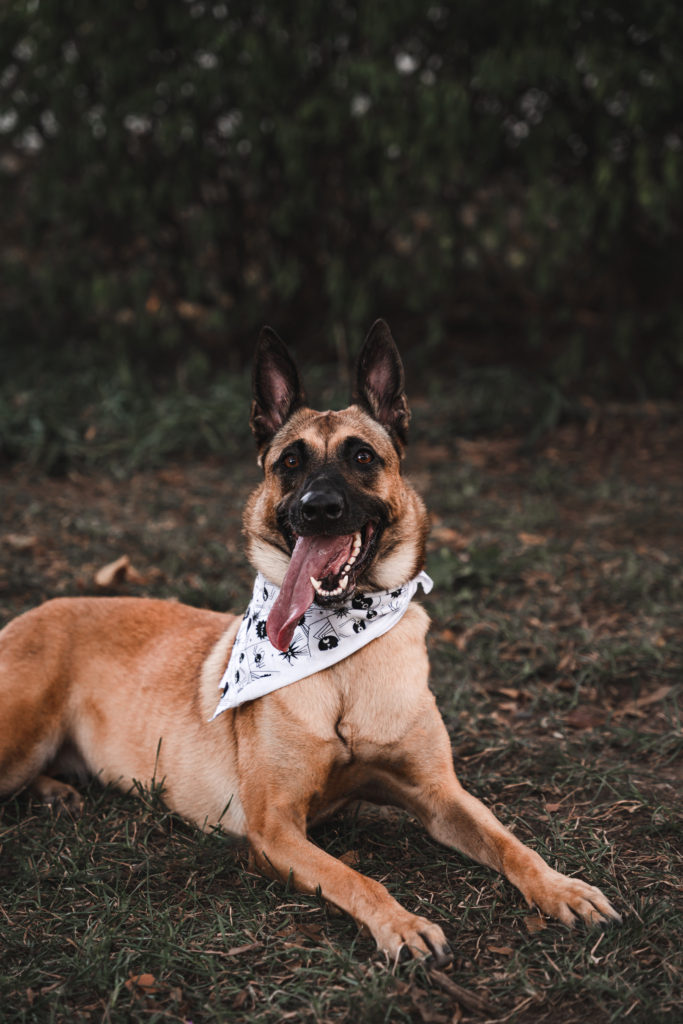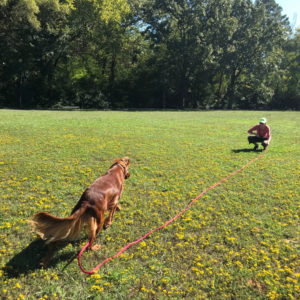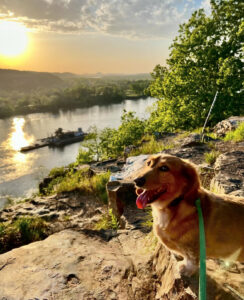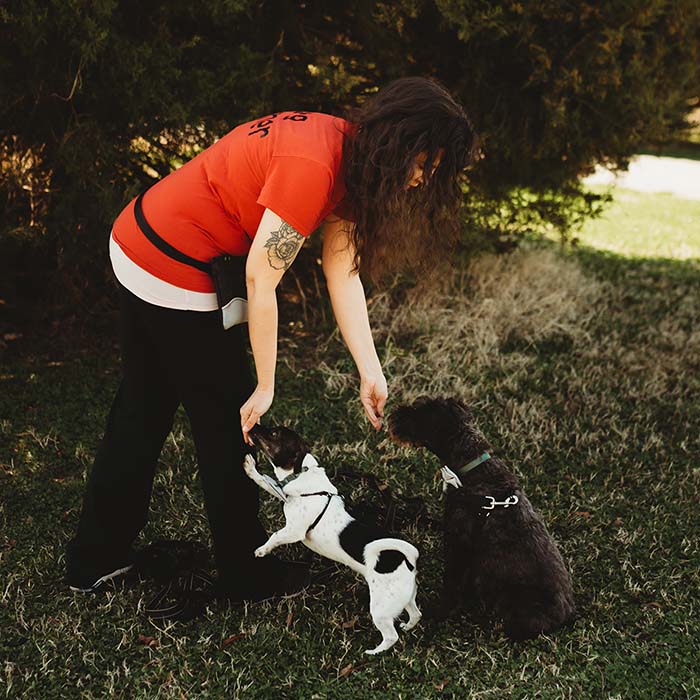When I started the walk with Rosie, I had twenty minutes to get to my next client. This walk was supposed to take ten minutes. The client lived seven minutes away. But we were quickly burning time as Rosie, my rescue Belgian Malinois, was refusing to walk. I felt the familiar rage flare up. If I couldn’t get to a client, I couldn’t make money, and I couldn’t keep a roof over her head. She didn’t know any of that, but somehow, I felt like she should.

Big emotions are something I see regularly while working with dog training clients. I know different emotions outside of anger are the true inciting feeling, like:
– Embarrassment (what do others think of me or my dog);
– Fear (what if my dog does something to hurt another dog or what if my dog gets hurt);
– Frustration (why is my dog reacting like this); and
– Exhaustion (I’ve worked so hard on this issue, and my dog is still having problems).
I often tell new clients that I didn’t come to their home to witness their perfect dog, which breaks the ice quite a bit.
(Clarification note: It’s important to remember that abuse and anger aren’t the same thing. I see actual abuse when it comes to professional dog trainers, with severe yanking, or the yank and crank, rough handling, not cleaning up crates or the dogs, withholding food, burns to the neck, strangulation symptoms (coughing, spine issues), etc. I don’t run into these issues personally with my clients, but I do know it’s happening in the local community and in the world on a larger scale.)
I just didn’t feel some of these stronger feelings myself until I got Rosie. I knew she was going to be a challenge, but I had no idea how much of a challenge she would prove to be, from intense dog reactivity and aggression to swallowing chicken bones and kabob sticks on walks. The first month or two I had her, she somehow got into rat poison and had green poop, which cost $500 to take her and my other two to the emergency vet just in case. She’s cost me thousands of dollars in the year and a half since then.
Eileen Anderson, a gifted dog writer, and I recently chatted about anger and how we see it present. We discussed our embarrassment and how we feel when we think we’re being judged. It turns out, we both get compliments on our challenging dogs when we’re out and about on walks. We’re the ones doing the judging of ourselves, and absorbing the feelings that come with it. We feel that our dogs could be more responsive, do less scavenging, be better on a leash, when they’re doing just fine. She wrote about her observations on anger here.
I love seeing little moments of realization in my classes too, usually about class three, when clients start to understand that their dogs are doing just fine, and the people were just miscommunicating. Their dog actually does want to engage and listen. It was just misapplication of treats, or contradictory body movements to verbal cues. Most of my job is problem solving and helping dog guardians strengthen their relationships with their dogs via clear communication.
I’ve seen more extreme methods of miscommunication as well, outside of my work, whether it was a man abruptly jerking around a very young German Shorthaired Pointer puppy, or the woman doing the same with a full-grown German Shepherd. Those were acts of anger, covering up their embarrassment. I knew if I had said anything to either of them, the dog would have born the brunt of me seeing through their mishandling.
I learned that the hard way with dogs off-leash. There’s no one more embarrassed than the person who thought their dog would stay with them off-leash. They’re the ones yelling at their dog, who is reacting normally in a situation that the human created. I started saying, “It’s not your dog’s fault.” This has had the effect of diffusing the situation and the emotions for them to think on later.
The reality is that most people know much less than they think they do about dogs, and the dogs bear the brunt of that lack of knowledge. I knew barely anything before I became a dog trainer, but I was convinced I knew so much. I absorbed so much in my first six months of being a dog trainer intern that I couldn’t believe the silly things I’d thought before.
There are a lot of conversations happening in the dog world at the moment, including the realities of the abuse perpetrated by the Dog Daddy, Augusto Deoliveira, and the insistence that science has no place in dog training. The more I see and engage in conversations, the more I realize that a lack of education is the issue. There are a lot of folks working hard to combat this, especially Zak George, but social media like TikTok and Instagram’s reels, rewards the quick fix or the aversive method that looks like it works.
(Clarification: I’ve asked some questions of folks in comment sections, and some are willing to engage and do genuinely want to learn, and some don’t and who make a mockery of those trying to stop abuse. I’ve found that the folks who want to learn don’t understand how behavior modification works, why the dogs Augusto jerks around are being set up to fail, and what dog body language has to do with any of it. A dog with severe reactivity issues should not ever be in a public setting, near a lot of other strange dogs and people, and should not be punished for their behavior as a result. Dog body language helps us see if a dog is actually learning or if they’re being shut down. Most dogs don’t learn in this setting.)
Eileen wanted to examine if an anger display was a part of the aversive training, but found a disconnect between the platformed trainers using those methods and the average person who did display anger in their face while handling their dog. She also mused on habit, which can establish using correction for no particular reason, versus a correction born out of perceived need or embarrassment.
Realistically, we’re all likely to be embarrassed by our dogs at some point.
The first time I felt absolute rage with Rosie was when I was putting on her harness, bent over her, and she bucked up, slamming into my face with her head. I knew instantly that I was bleeding, and the pain was unreal. I’d been punched in the face with a dog’s head before, a 130-lb Great Dane, but I hadn’t felt anger at that dog. I’d felt simply hurt and sad. With Rosie, I cursed and threw some stuffed toys across the room before going to the bathroom to check out the damage. A fat lip and blood dripping down my face. This was how this dog repaid for me everything I’d done for her? The absolute nerve. I felt like I’d made a massive mistake with this dog and she didn’t belong with me. But I didn’t lay a hand on her or correct her for the incident. It wouldn’t have done anything except given me temporary relief via displacement for my feelings.
I shouldn’t have cursed or thrown anything. I should have just removed myself. But coming from dysregulation, I hadn’t grown up learning how to feel and regulate my emotions. And Rosie was forcing me to. It wasn’t fun.
I started embracing that feeling the emotion is fine and important, acting on the anger doesn’t have a place in dog training. We know punishment works. Punishment, just as much as positive reinforcement, is backed by science. However, we also know that punishment is more for the benefit of the handler than the dog, and that there is always the risk of fallout when it comes to using aversives or punishment. This will vary by dog. Eileen has previously written about the fallout of aversives here, as has Cathy Madson of Preventive Vet.
But we’re human, and our emotions will always pop up.
To combat this, we owe it to our dogs to check in with ourselves. If a walk will be marked by anger, don’t go. If you can’t give your dog your best, take a break. Do an enrichment activity instead of a walk. Try a half day at daycare instead of a training activity. Something that strikes me about online advice is how little of it is universal, whether aimed at people or dogs. Some people need to do more with their dog. Others could do a little less. Some folks should enact more defined boundaries. Others could do with giving way a little bit more.
Remember: Feeling anger is different than acting on anger.
Causes I’ve seen for displays of anger:
- This is what I was taught to do/this is what I have to do to have a good dog
- This is because I am embarrassed
- This is because I am frustrated
- This is because I am at my limit or I am way past my limit
- This is because I am afraid
- This is a necessary punishment for undesirable behavior
Get your dog safe, first, if needed, then take a moment and regulate those emotions. Walk away if you can. Remember that dogs are just dogs, doing what works. They’re not trying to make you look stupid. They’re not trying to dominate you. We’ve been fed a lot of lies, and there are a lot of dog professionals building platforms on those lies, while targeting dog guardians trying to do their best by their dog. I’ve seen professional dog trainers make dog guardians feel bad so the trainer feels superior about their lack of expertise. This can also look like not having the experience to help a dog, and the dog trainer suggesting euthanasia instead of referring out. Unskilled people, unhealed people, and fearful people, would rather attack and demean before they ever admit that they don’t have the tools to be successful.
There’s another aspect to consider in the competition ring. Agility or rally folks aren’t always professional dog trainers, but they do tend to have more training experience than the average dog owner. Lexi and I took an agility course last year, and we ended up stopping because it was really hard to watch how other folks handled their dogs and listen to what they said to their dogs. One person was handling a nine-month-old dog, fully an adolescent doing adolescent things (not listening very well, getting distracted easily, wanting to play instead of work), and the person told their dog, “Don’t make me do to you what I did to your brother.” My stomach dropped. I don’t even know what that even means but I didn’t want to hear something like that.
As I’ve progressed as a dog trainer, I’ve found that one of the most unfortunate situations for someone trying to do their best by their dog (or not, depending on the situation) is for another person to observe the situation. Even worse, for the person approach them and point out their failure. So when they are embarrassed, they will hurt, yank, force, to show that they are in charge, that they have their dog under control.
I believe that this stems from several things: childhood trauma, a lack of education and practice, maintaining what they’ve always done or what they were taught, and then something that rarely comes up but what I call media conditioning.
Media conditioning is perpetrated by books, television shows, and movies like:
- Lassie
- National Velvet
- Where the Red Fern Grows
- Ol’ Yeller
- Free Willy
- Black Beauty
- Misty of Chincoteague
- Wild Hearts Can’t Be Broken
- The Man from Snowy River
- Flicka
I consumed all of this and more as a child, and each story immensely impacted my expectations of animals. I actually decided not to pursue an animal career at the age of 12 because I tried talking to a scared, bucking stallion who didn’t care about what I was doing or who I was, and I fled in embarrassment. I didn’t become a dog trainer until I was 31.
I don’t think my situation is unique. I think humans bring their “soul dog” expectations, “the rescue dog will just be grateful to be rescued”, their natural beginning ability into their relationships with their dogs, and then they end up being disappointed when it’s not enough, and it’s embarrassing. It’s embarrassing to admit you don’t know what you’re doing, and it’s devastating for anyone to point it out.
I keep waiting for someone to point out that I’m failing my Belgian Malinois. I decided she needed to be picked up so I could make my client appointment in time. She was heavy and we had to take a lot of breaks. And someone noticed. A man yelled at me from his truck that she was bigger than I was. My embarrassed response was saying that she was being ridiculous.
But she wasn’t being ridiculous. The whole situation was ridiculous, but it was also the least consequential choice I could have made. She was anxious and she was having a hard time. Correcting her or dragging her would have made her anxiety worse. Instead, she let me carry her. She wasn’t sure what I was doing, but she was okay with it, and as a result, our relationship didn’t take a hit. Next time, I’ll adjust more for those moments.
We’re working on her anxiety. I’m working on managing my anger appropriately.
We’ve both come a long way.




